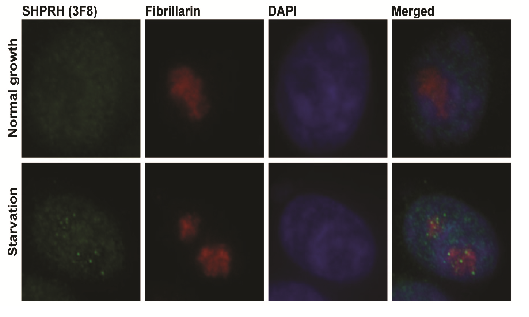New protein regulated by cellular starvation

Researchers at the Center of Genomic Integrity, within the Institute for Basic Science (IBS), have found out an unexpected role for a protein involved in the DNA repair mechanism. The protein SHPRH not only helps to fix mistakes generated during DNA replication, but also contributes to the generation of new ribosomes, the cell's "protein factories." The newly discovered task depends on the nutritional state of the cell and might be associated with aging and anemia. This research has been recently published in the Proceedings of the National Academy of Sciences (PNAS).
"Some proteins that repair damaged DNA are produced by the cells at high quantities even when there are no DNA mistakes to correct," explains MYUNG Kyungjae, corresponding author of the study. "Therefore we thought the protein was likely to have another role beyond DNA repair." It turns out that SHPRH joins the category of proteins that have plural functions.
A clue about the extra function of SHPRH came from its location in the cell. IBS researchers identified where SHRPH localizes inside mammalian cells. They discovered that SHPRH is located inside the cell's nucleus, in particular sections of the nucleus where ribosomes are made, known as nucleoli.
Interestingly, when no new nutrients were added to the cells for multiple days, clusters of SHPRH appeared. This triggered the idea to test SHPRH behavior during cellular starvation. As expected, the research team found that just two hours after growing cells without nutrients in the experiment, SHPRH clusters (or foci) appeared, and when nutrients were added, they disappeared again.
Since nucleoli are the production sites of ribosomes, IBS scientists investigated SHPRH's role in ribosome synthesis and clarified that the second function of SHPRH in mammals is associated with the transcription of rRNA, an essential component of ribosomes. "DNA repair proteins are often connected with the growth function. For example, the rate of cell proliferation depends on the rate of protein synthesis, which is regulated by the ribosome and the rRNA," points out LEE Deokjae, the first author of the study. Since flaws in ribosome biogenesis are connected with several metabolic problems; aging, anemia and cancers, studying these proteins is very promising. "When cells lack nutrition, they cannot grow normally, they slow their energy consumption and reduce ribosome production."
In case of cellular starvation, SHPRH is clustered in foci and dissociated from ribosomal DNA that is packed in a so-called 'poised' state, ready to be active as soon as the cell has enough nutrients. For this reason, if nutrients are added during a time of starvation, the SHPRH spots disappear and ribosome production can be quickly recovered.
"We have yet to clarify the exact role of these SHPRH foci," comments Lee. "Are they just a temporary trash bin of unnecessary proteins? Are they connected with aging? We still do not know, but we have several hypothesis. Future experiments will tell."
More information: Deokjae Lee, Jungeun An, Young-Un Park, Hungjiun Liaw, Roger Woodgate, Jun Hong Park, and Kyungjae Myung. SHPRH regulates rRNA transcription by recognizing the histone code in an mTOR-dependent manner. PNAS. April 2017. DOI: 10.1073/pnas.1701978114
Journal information: Proceedings of the National Academy of Sciences
Provided by Institute for Basic Science





















